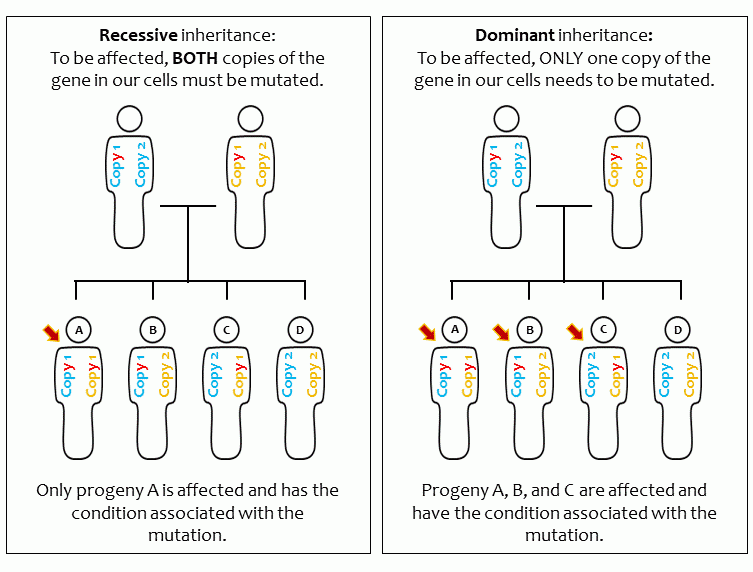LGMD2I is a disease caused by a mutation in ONE gene. The inheritance of this kind of pathogenic mutations follows the rules explained below and in many other websites (see “More Information” below).
LGMD2I is a recessive disease:
An important aspect of the inheritance of LGMD2I mutations is that it is recessive. Recessive inheritance is opposed to dominant inheritance. The most known example of recessive versus dominant inheritance is the color of our irises, the circular structure in the eye that controls the diameter of the pupil. The colors blue and green are said to be recessive traits. The brown color is said to be the dominant trait.
We all have 2 copies of our genome, and therefore 2 copies of the FKRP gene. One copy comes from the father and the other copy comes from the mother.
LGMD2I arises when BOTH copies of the FKRP gene are mutated (the copy from the father and the copy from the mother). It is called “Recessive” inheritance because BOTH parental copies need to be altered (see diagrams below).
[In rare cases, the pathogenic mutation is not coming from any of the parents but it is created anew during the development of the embryo. Still, a person needs both copies of the FKRP gene mutated to have LGMD2I.]
Our 2 copies of the FKRP gene are continuously expressed, creating a pool of FKRP protein, that is, to simplify, 50% coming from gene copy 1 and 50% coming from gene copy 2. Any significant mutation in the FKRP gene will create a change in the FKRP protein.
Probability and the inheritance of a mutation:
Below are drawings to explain the relationship between inheritance and probability. They answer the question: what is the likelihood for the progeny to have LGMD2I knowing the genetics make-up of the parents? The first set of drawings shows the inheritance and probability of the transmission of any gene. The second set of drawings applies this knowledge to the transmission of mutations causing LGMD2I.
1. General knowledge: the inheritance of genes
Each person has 2 copies of any gene.
For simplification, the 2 copies of a given gene A are named copy 1 or copy 2 in the example below, and, are blue in person 1 and ocher in person 2.
Because each parent gives one copy of the gene A to their kids, each kid carries any one of 4 possible combinations for the make-up of gene A.

Consequently, if each parental copy of gene A has the same chance of being transmitted, each kid will have 1 in 4 or 25% chance to carry any one genotype (a specific combination of the 2 gene copies).
What about “recessive” inheritance versus “dominant” inheritance?
As explained in the introduction, both copies of a gene need to be mutated to cause a recessive disease. For simplification, the mutation carried by each parental copy of gene A is marked by a red-colored “y” in the word copy.

2. LGMD2I follows the pattern of recessive inheritance as shown above
The table below shows all the cases of transmission of mutation based on parents’ mutational status.
